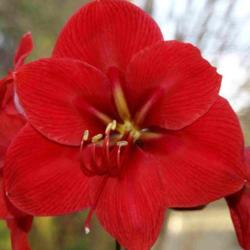Amaryllis and Hippeastrum have a long history in lore. We'll continue our celebration by exploring some fun facts about these plants.
The Greeks are known for their grand tales of heroes and epic battles. The beautiful amaryllis found its place there as well. Amaryllis means “to sparkle” in Greek. The name seems to have been derived from a poem by Virgil, in which the flower was named for a shepherdess who fell madly in love with a gardener named Alteo. The shepherdess, Amaryllis, walked a path to his door daily for one month and pierced her own heart each day with a golden arrow. The blood from Amaryllis' heart created our well-loved flowers along the path. The tale certainly gives a dramatic beginning to our well-loved flowers!
The symbolism of the flower continues through the ages. In Victorian times, the amaryllis was most commonly given by a man to the woman he admired, as the red flower was meant to symbolize radiant beauty.
Hippeastrum, the Latin name of this flower, also has an interesting story. The name is derived from the Greek words for horse and star, or “horseman's star." According to the University of California's Cooperative Extension, the name was selected by the Dean of Manchester because of the likeness to a horse's head.
Most of us think of amaryllis as being a winter flower because they are commonplace during the holidays. As one of the easiest bulbs to force and bloom, it is no wonder that the United States imports more than 10 million bulbs from Holland and South Africa every year to keep up with demands. In nature, however, the amaryllis naturally blooms in spring and summer.
Here at ATP, our database lists over
500 varieties of Amaryllis, and there are more registered every year. It is a slow process to create new varieties. An amaryllis will take 6 years to reach maturity and bloom when grown from seed, and another 3-5 years for the bulbs to divide and grow into a marketable size. The wait is worth it, though, and a well-cared-for plant can live for 75 years!
It isn't hard to come up with reasons to celebrate a plant with such a long history and a past steeped in symbolism, not to mention the dramatic and long-lasting blooms that we are still enjoying ages later.

